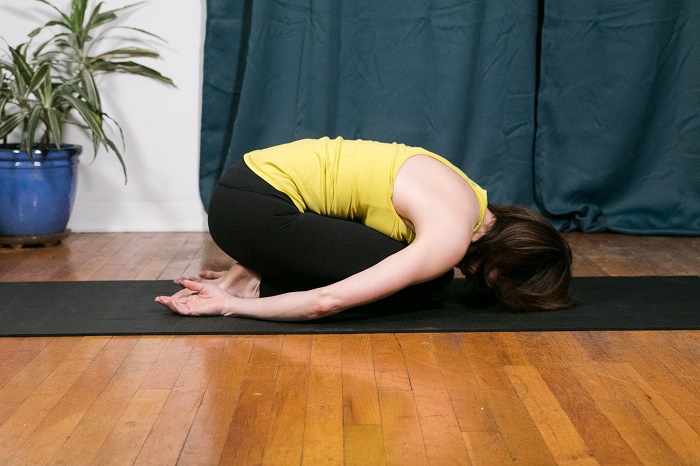

By Shannon McQuaide
It is no surprise that as a yoga teacher who specializes in working with firefighters, I have grown accustomed to hearing complaints about lower back pain (LBP). To make sure firefighters feel better rather than worse following a FireFlex Yoga class, I modify poses for specific types of LBP. Here’s why…
Directional Preference
LBP is often considered mechanical in nature and characterized by symptoms that are exacerbated or eased by movement or position. A concept that has drawn considerable attention in the literature for the care of LBP is directional preference. What this concept suggests is that specific movements may increase or decrease LBP symptoms. An individual who notices a decrease in symptoms with a specific movement would have a “preference” for this direction. Symptoms that increase with the movement and move down the leg would be referred to as “peripheralization,” and should be avoided because this can signify worsening of one’s condition.1
The Role of Yoga
Because movement significantly influences LBP, health care practitioners are prescribing yoga to reduce symptoms. However, this prescription is not as cut and dry as some practitioners may think, leaving many firefighters not feeling any better after a typical yoga class. In some cases, firefighters have sworn off yoga altogether because their LBP has increased. But is yoga the culprit?
Although the term yoga has become synonymous with a physical practice, it is not a single practice. In fact, there are a growing number of yoga styles, each with their own signature movements and routines. Bikram, yin, power, Astanga, hatha, vinyasa, aerial and acro are just a few popular yoga styles. Each of these styles involves varying degrees of difficulty and signature postures that pose unique challenges for firefighters with LBP.
Case Study
Let’s try to understand why a firefighter with LPB who has been prescribed yoga actually feels worse after attending a level 1 Vinyasa flow class. Our case study firefighter has a directional preference for back extension (see figure 1), meaning her LBP symptoms decrease while standing or walking. Movement that requires spinal flexion, like sitting or bending forward, increases her LBP (see figure 2).
At the beginning of class our case study firefighter rolls out her mat on the studio floor and takes a seat. Because of tight hamstrings and weak abdominal muscles, this sitting position causes this firefighter’s pelvis to tilt backwards, placing the spine in flexion, a position contraindicated for LBP with a directional preference for extension.
The class continues, with our case study firefighter performing 8 rounds of sun salutations, a conservative estimate for a level 1 Vinyasa flow. The class also includes standing postures, backward and forwarding bending postures, and ends with the traditional final resting pose, savasana.
Remembering that our case study firefighter experiences a decrease in LBP with spinal extension, let’s analyze how many spinal flexion poses are part of a level 1 Vinyasa flow class. We will consider only the postures that require spinal extension or flexion, and only postures practiced during sun salutations. For the sake of simplicity let’s imagine our case study firefighter is practicing Classical Sun Salutations, or Series C.
Within one complete cycle of Classical Sun Salutations, there are approximately 6 extension and 6 flexion postures each cycle. This firefighter is feeling pretty good in locust and cobra poses, but not so great in the forward folds. And because of tight hamstrings, this firefighter’s lower back is rounding (flexion) in downward facing dog pose. The total number of spinal flexion poses in the case study scenario is 48, and that does not include all the postures in addition to Classical Sun Salutation!
For me someone like me who has not suffered from LBP in over 15 years, I feel remarkable at the end of the Vinyasa flow class. However, our case study firefighter who has practiced a minimum of 48 spinal flexion postures may have written yoga off for good.

Solution: The Functional Movement Screen
Because of the frequency of LBP among firefighters, I have established a sound methodology for using specific and targeted yoga postures to help firefighters reduce their LBP symptoms. In next month’s column I’ll describe how I use the Functional Movement Screen in combination with yoga postures to provide relief.
Reference
- Hanney, William J., et al. “Low Back Pain: Movement Considerations for Exercise and Training.” Strength & Conditioning Journal 35.4 (2013): 99-106.
 Shannon McQuaide is a registered yoga instructor with Yoga Alliance and the founder of the FireFLEX YogaTM program. FireFLEX Yoga was developed through her work with the San Jose (CA) Fire Department, where she continues to lead FireFLEX Yoga classes. She is a certified functional movement trainer and has a master of arts degree in leadership and psychology. Shannon@fireflexyoga.com http://www.fireflexyoga.com.
Shannon McQuaide is a registered yoga instructor with Yoga Alliance and the founder of the FireFLEX YogaTM program. FireFLEX Yoga was developed through her work with the San Jose (CA) Fire Department, where she continues to lead FireFLEX Yoga classes. She is a certified functional movement trainer and has a master of arts degree in leadership and psychology. Shannon@fireflexyoga.com http://www.fireflexyoga.com.

